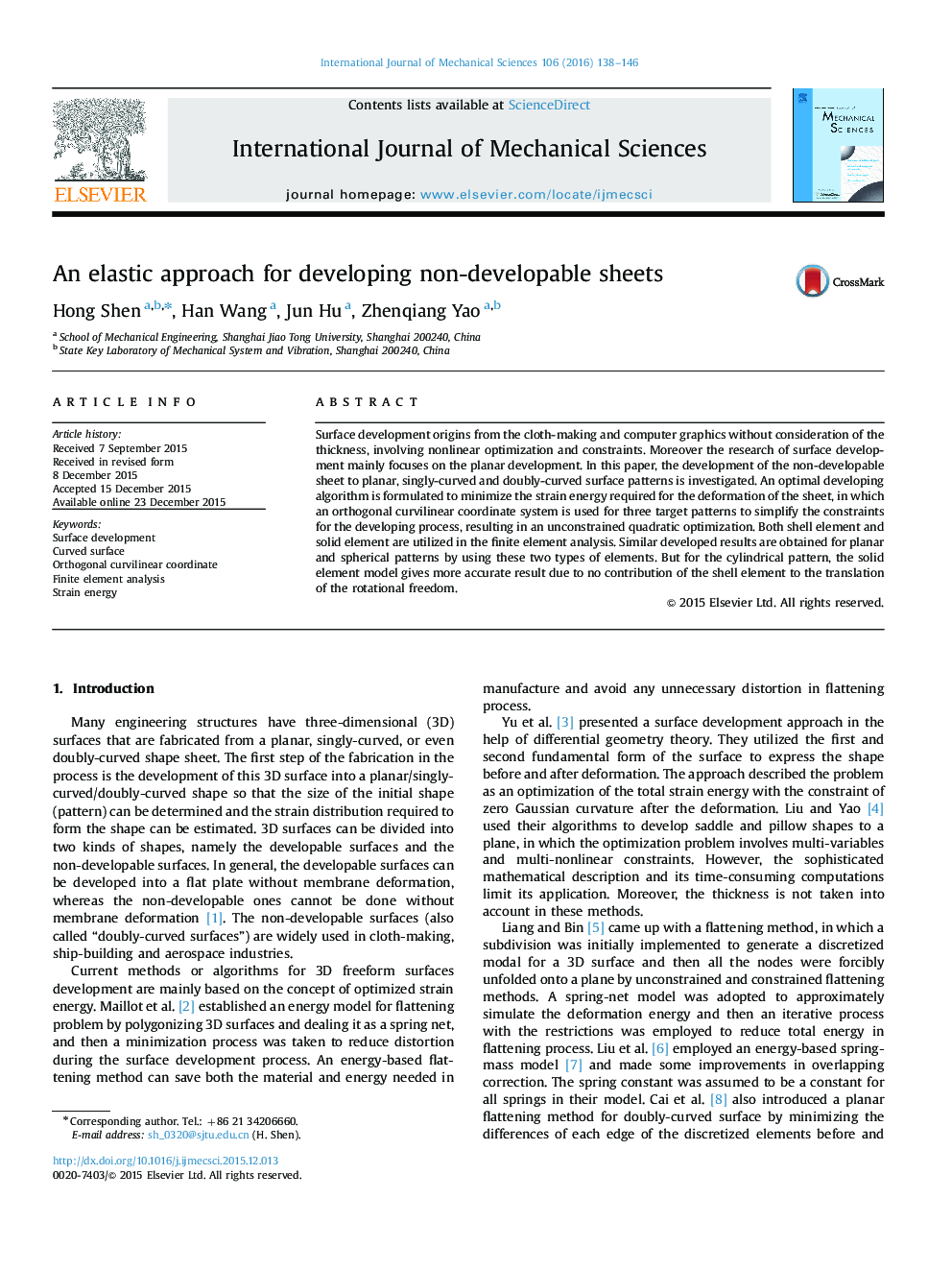| کد مقاله | کد نشریه | سال انتشار | مقاله انگلیسی | نسخه تمام متن |
|---|---|---|---|---|
| 7174173 | 1464977 | 2016 | 9 صفحه PDF | دانلود رایگان |
عنوان انگلیسی مقاله ISI
An elastic approach for developing non-developable sheets
ترجمه فارسی عنوان
یک رویکرد الاستیکی برای ایجاد صفحات غیر قابل توسعه
دانلود مقاله + سفارش ترجمه
دانلود مقاله ISI انگلیسی
رایگان برای ایرانیان
کلمات کلیدی
توسعه سطح، سطح منحنی، مختصات منحنی متعارف، تجزیه و تحلیل عنصر محدود، نیروی کششی،
ترجمه چکیده
ریشه های توسعه سطح از طراحی پارچه و گرافیک کامپیوتر بدون توجه به ضخامت، شامل بهینه سازی غیر خطی و محدودیت ها. علاوه بر این، تحقیق در زمینه توسعه سطح زمین به طور عمده بر روی توسعه مسکن تمرکز دارد. در این مقاله، توسعه ورق غیر قابل توسعه به الگوهای سطح، منحنی منحنی و دو طرف منحنی بررسی شده است. یک الگوریتم در حال توسعه بهینه برای حداقل سازی انرژی فشار مورد نیاز برای تغییر شکل ورق تشکیل شده است، که در آن یک سیستم مختصات منحنی متعامد برای سه الگوی هدف برای ساده سازی محدودیت های فرآیند توسعه استفاده می شود که منجر به بهینه سازی درجه دوم بدون محدودیت می شود. هر عنصر پوسته و عنصر جامد در تجزیه و تحلیل عناصر محدود استفاده می شود. نتایج مشابهی برای الگوهای مسطح و کروی با استفاده از این دو نوع عناصر به دست می آیند. اما برای الگوی استوانه ای، مدل عنصر جامد نتیجه دقیق تر را به دست می دهد زیرا هیچ مشکلی از عنصر پوسته به ترجمه آزادی چرخشی ندارد.
موضوعات مرتبط
مهندسی و علوم پایه
سایر رشته های مهندسی
مهندسی مکانیک
چکیده انگلیسی
Surface development origins from the cloth-making and computer graphics without consideration of the thickness, involving nonlinear optimization and constraints. Moreover the research of surface development mainly focuses on the planar development. In this paper, the development of the non-developable sheet to planar, singly-curved and doubly-curved surface patterns is investigated. An optimal developing algorithm is formulated to minimize the strain energy required for the deformation of the sheet, in which an orthogonal curvilinear coordinate system is used for three target patterns to simplify the constraints for the developing process, resulting in an unconstrained quadratic optimization. Both shell element and solid element are utilized in the finite element analysis. Similar developed results are obtained for planar and spherical patterns by using these two types of elements. But for the cylindrical pattern, the solid element model gives more accurate result due to no contribution of the shell element to the translation of the rotational freedom.
ناشر
Database: Elsevier - ScienceDirect (ساینس دایرکت)
Journal: International Journal of Mechanical Sciences - Volume 106, February 2016, Pages 138-146
Journal: International Journal of Mechanical Sciences - Volume 106, February 2016, Pages 138-146
نویسندگان
Hong Shen, Han Wang, Jun Hu, Zhenqiang Yao,
